RaceWire and the RFID Race Timing Industry

As the prevalence of timing races with RFID technology continues to grow in popularity, race timing and service provider RaceWire has emerged as a respected leader in the industry. Founded in 2009, RaceWire has grown rapidly. To understand how they set themselves apart in a highly competitive industry, the atlasRFIDstore team sat down with RaceWire co-founder Ryan Henry to discuss their history, success, and future plans. Ryan also shared his thoughts and predictions on where race timing as an industry is headed in the future.
Beginnings
Ryan first became interested in the race timing industry around 13 years ago when his family started a road race honoring the memory of his brother, Evan Henry. The inaugural Evan’s Run was a success and continues to take place every year in the New England area benefitting the Evan Henry Foundation for Autism.

After several years of involvement with Evan’s Run, Ryan invested in his own RFID timing equipment and started timing races on the weekend. To accelerate the growth of his knowledge in RFID and the timing industry, Ryan spent countless hours testing his system, reading publications, and speaking with industry veterans. The amount of races he timed grew as his familiarity with the industry increased.
As Ryan devoted more and more time to the process, he and his business partner noticed a service gap in the race timing industry. Many race timers were not offering a full suite of features designed to lift the burden of event management for race directors. To take advantage of this business opportunity, they developed an online race registration and management system. By incorporating race timing and management services, RaceWire streamlined pre-race procedures for both race directors and participants. Dealing with one vendor for multiple services proved advantageous for race directors, and RaceWire’s list of customers has steadily grown in number.
Changes in the Industry
Before the prevalence of chip timing, race directors primarily used stop watches or the “pull tag timing” method. In the “pull tag timing” method, once the participants cross the finish line, an operator stops the clock for that person, tears off a small tag with their bib number, and then writes the number down on a clipboard. While some timers still use this method and vouch for its accuracy in smaller races, it is increasingly being phased out in favor of RFID chip timing systems.
In the timing industry today, disposable RFID tags, or wet inlays, are the preferred method of tagging for most races; however, before the popularity of disposable tags, race timers operated with bulky, reusable RFID tags in order to obtain accurate times. Reusable tags are somewhat of a hindrance to the race timing industry as they are expensive and require a considerable amount of prep time before a race. If race timers have events back to back, they cannot adequately prepare ahead of time as all the tags from the first race must be collected before they can be used in the second race.

With reusable tags, the first step in the process is creating the bibs for all participants and shipping them to the race directors a week before the race. On the day of the event, race timers arrive a few hours early to set up the equipment and register any late arrivals. As soon as the race is finished, they start the tedious process of retrieving all the tags from the race participants. However, there is no guarantee that all of their reusable tags will be returned after a race, which adds to the overall costs. After collecting the tags, they go through a processing and cleaning routine, and the tags are then ready for the next race. Because reusable tags are often not returned, race timers are forced to pass the cost for replacements to the race directors.
Since RaceWire has switched to a timing system compatible with disposable tags, they make race bibs weeks in advance with no worry about running out or losing tags. Large, professional timing companies like RaceWire order large quantities of RFID tags well in advance of events and finish making all the bibs well before a race drastically reducing preparation time. Ryan switched to disposable tags in March 2011 and says it’s the biggest change in the RFID timing industry in quite some time. Disposable RFID tags have revolutionized the race timing industry.
Race Timing Chips & Tags
RaceWire has been leading the timing industry in New England and southern California. Depending on the length of the race and the number of participants involved, RaceWire’s RFID timing system hardware configuration may change from event to event. RaceWire needed a tag they could depend on for almost every situation. Since their switch to the disposable RFID tags, RaceWire has been particularly pleased with the performance of the SMARTRAC ShortDipole tag with the Monza 5 chip. In just this year alone, RaceWire will use hundreds of thousands of ShortDipoles in events all over the country. After rigorous testing, Ryan and his team found that the Monza 5 ShortDipole’s performance is second to none in terms of read accuracy.
“There is a big difference in 99% and 99.9% in the timing world. We have been really happy as far as the tag and read range we are getting”
However, the SMARTRAC ShortDipole isn’t used in all of Racewire’s races. When RaceWire times triathlons, they require a durable tag that performs well around water. In these races where swimming in water is a large leg of the course, they use the Confidex Halo RFID tag with a special backing to obtain a reliable read rate. Since Confidex Halos are typically strapped around participants’ ankles during all three parts of the course, RaceWire strategically places linear RFID antennas throughout the course to accurately read these tags.
Race Timing Systems
New comers to the race timing industry either create their own system or buy a complete system. RaceWire is extremely pleased with their system purchased from RFID Timing Systems headquartered in Australia. For some timers, the upfront cost associated with purchasing a complete system isn’t worth it. To others like Ryan, the confidence gained by knowing that their systems are rigorously tested and continually improved upon is extremely valuable and worth the investment.
Where is the Industry Going?
For an industry that was still using stopwatches until recently, the race timing landscape has changed considerably since its inception. As the industry moves into its next phase, an emphasis on the consumer will increase as companies seek new ways to differentiate themselves from the competition.
Providing value-added services like social media, photography, online registration, and videos for the races will soon become the norm. In the age of social media, race participants want to share their experiences online with their friends and family. Timing solutions that text, email, and post the participants’ pictures and times have become a common request and is starting to become an expected feature. Companies like RaceWire have mastered the technical aspects of timing and are now focused on providing their clients with these extra services.
About atlasRFIDstore
atlasRFIDstore is an eCommerce website focusing on RFID technologies including UHF, NFC, and HF. We have a very customer centric philosophy at atlasRFIDstore. We work hard to develop consultant-like relationships with our customers so that they have the necessary knowledge to implement our partners’ products in successful applications. In order to provide the high level of customer service, we have to be experts on every product sold from our store and have implemented training requirements in place promoting continuing education. With our expertise in RFID technologies, we’re able to help customers no matter their situation or application.
If you are interested in implementing RFID in your race timing solutions, starting now will save you money in the long run. If you have any questions, please email us at info@atlasRFIDstore.com or call us at (888) 238-1155.
